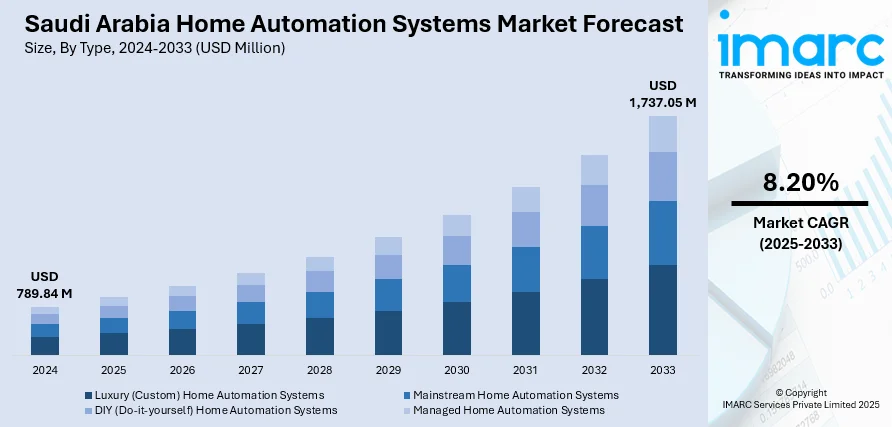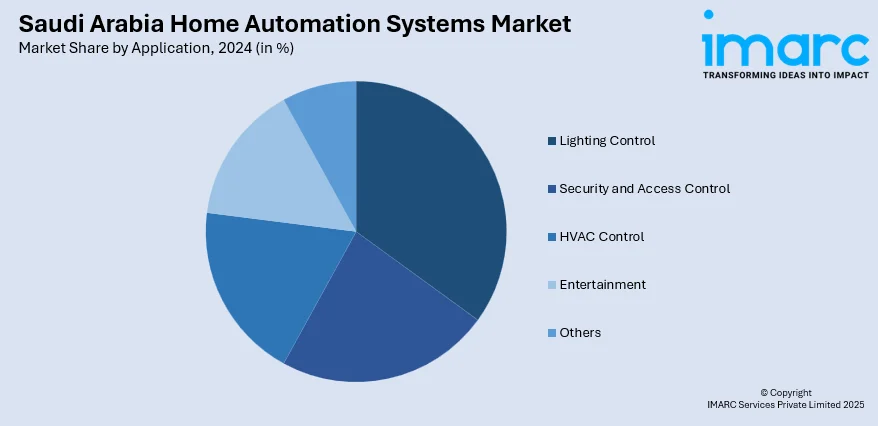
Saudi Arabia Home Automation Systems Market Size, Share, Trends and Forecast by Type, Application, and Region, 2025-2033
Saudi Arabia Home Automation Systems Market Overview:
The Saudi Arabia home automation systems market size reached USD 789.84 Million in 2024. Looking forward, IMARC Group expects the market to reach USD 1,737.05 Million by 2033, exhibiting a growth rate (CAGR) of 8.20% during 2025-2033. The market is driven by increasing demand for smart homes, spurred by a growing middle class and disposable income. Further technological advances in IoT, AI, and smart devices are enhancing comfort and convenience, security, and energy efficiency, which is providing a boost to the market growth. Additionally, government interventions related to energy-efficient and sustainable solutions effectively augment the Saudi Arabia home automation systems market share.
|
Report Attribute
|
Key Statistics
|
|---|---|
|
Base Year
|
2024
|
|
Forecast Years
|
2025-2033
|
|
Historical Years
|
2019-2024
|
| Market Size in 2024 | USD 789.84 Million |
| Market Forecast in 2033 | USD 1,737.05 Million |
| Market Growth Rate 2025-2033 | 8.20% |
Saudi Arabia Home Automation Systems Market Trends:
Increased Adoption of Smart Home Devices
The market is witnessing a significant increase in the use of smart home devices, including smart thermostats, lighting systems, and security systems. The growing demand for increased convenience, energy efficiency, and security in homes primarily drives the trend. Moreover, the increase in consumer demand for smart devices has been largely driven by technological advancements in Internet of Things (IoT) technologies, which enable end-to-end connectivity between devices. As people gain more awareness of the advantages of home automation, such as the ability to control appliances, reduce energy consumption, and improve security remotely, they are increasingly integrating these devices into their households. This change is not only spurred by technological advancements but also by a need for increased convenience. For instance, in 2023, Alexa was employed to manage home lighting 24 million times in the UAE and KSA. Moreover, the emergence of e-commerce websites and the presence of affordable, easy-to-use smart home offerings have made these solutions available to a broad base. In addition, there is a growing preference for amalgamating different smart devices, allowing for unified control via mobile apps and thus improving the overall user experience. This trend in adoption is likely to fuel huge market growth in the future.

Government Initiatives and Vision 2030
The kingdom's Vision 2030 initiative plays a crucial role in accelerating the Saudi Arabia home automation systems market growth. The kingdom, with a population of 32.2 million and 83% of its residents residing in urban areas as of 2023, is undergoing rapid modernization to meet the goals outlined in Vision 2030. The government's emphasis on digital transformation, energy efficiency, and sustainability is evident in high-level investments in smart city schemes and the promotion of smart homes. These efforts focus on improving the general standard of living with a decreased environmental footprint, and home automation systems are at the core of this shift. Additionally, specific efforts, such as the Smart Cities initiative, which focuses on integrating next-generation technologies into city planning, involve extensive investment in smart home technologies. Furthermore, policies aimed at reducing energy usage, such as encouraging the adoption of energy-efficient technologies, are creating demand for home automation products designed to achieve energy savings. In efforts to diversify the economy and reduce reliance on oil, the government is prioritizing innovation in technologically driven industries, with home automation being a crucial segment. These initiatives by the government are encouraging both domestic demand and offering companies within the industry the kind of support required to flourish.
Saudi Arabia Home Automation Systems Market Segmentation:
IMARC Group provides an analysis of the key trends in each segment of the market, along with forecasts at the country and regional levels for 2025-2033. Our report has categorized the market based on type and application.
Type Insights:
- Luxury (Custom) Home Automation Systems
- Mainstream Home Automation Systems
- DIY (Do-it-yourself) Home Automation Systems
- Managed Home Automation Systems
The report has provided a detailed breakup and analysis of the market based on the type. This includes luxury (custom) home automation systems, mainstream home automation systems, DIY (do-it-yourself) home automation systems, and managed home automation systems.
Application Insights:

- Lighting Control
- Security and Access Control
- HVAC Control
- Entertainment
- Others
A detailed breakup and analysis of the market based on the application have also been provided in the report. This includes lighting control, security and access control, HVAC control, entertainment, and others.
Regional Insights:
- Northern and Central Region
- Western Region
- Eastern Region
- Southern Region
The report has also provided a comprehensive analysis of all the major regional markets, which include Northern and Central Region, Western Region, Eastern Region, and Southern Region.
Competitive Landscape:
The market research report has also provided a comprehensive analysis of the competitive landscape. Competitive analysis such as market structure, key player positioning, top winning strategies, competitive dashboard, and company evaluation quadrant has been covered in the report. Also, detailed profiles of all major companies have been provided.
Saudi Arabia Home Automation Systems Market News:
- On June 4, 2024, Honeywell inaugurated its first assembly line for fire alarm and building management solutions in Dhahran, Saudi Arabia, marking a notable expansion of its building automation capabilities in the Middle East. This facility aims to provide locally manufactured products adhering to both local and international standards. The initiative is expected to streamline the delivery of critical safety technologies, enhancing operational efficiency and contributing to advancing automation in the Kingdom.
Saudi Arabia Home Automation Systems Market Report Coverage:
| Report Features | Details |
|---|---|
| Base Year of the Analysis | 2024 |
| Historical Period | 2019-2024 |
| Forecast Period | 2025-2033 |
| Units | Million USD |
| Scope of the Report |
Exploration of Historical Trends and Market Outlook, Industry Catalysts and Challenges, Segment-Wise Historical and Future Market Assessment:
|
| Types Covered | Luxury (Custom) Home Automation Systems, Mainstream Home Automation Systems, DIY (Do-it-yourself) Home Automation Systems, Managed Home Automation Systems |
| Applications Covered | Lighting Control, Security and Access Control, HVAC Control, Entertainment, Others |
| Regions Covered | Northern and Central Region, Western Region, Eastern Region, Southern Region |
| Customization Scope | 10% Free Customization |
| Post-Sale Analyst Support | 10-12 Weeks |
| Delivery Format | PDF and Excel through Email (We can also provide the editable version of the report in PPT/Word format on special request) |
Key Questions Answered in This Report:
- How has the Saudi Arabia home automation systems market performed so far and how will it perform in the coming years?
- What is the breakup of the Saudi Arabia home automation systems market on the basis of type?
- What is the breakup of the Saudi Arabia home automation systems market on the basis of application?
- What is the breakup of the Saudi Arabia home automation systems market on the basis of region?
- What are the various stages in the value chain of the Saudi Arabia home automation systems market?
- What are the key driving factors and challenges in the Saudi Arabia home automation systems market?
- What is the structure of the Saudi Arabia home automation systems market and who are the key players?
- What is the degree of competition in the Saudi Arabia home automation systems market?
Key Benefits for Stakeholders:
- IMARC’s industry report offers a comprehensive quantitative analysis of various market segments, historical and current market trends, market forecasts, and dynamics of the Saudi Arabia home automation systems market from 2019-2033.
- The research report provides the latest information on the market drivers, challenges, and opportunities in the Saudi Arabia home automation systems market.
- Porter's five forces analysis assist stakeholders in assessing the impact of new entrants, competitive rivalry, supplier power, buyer power, and the threat of substitution. It helps stakeholders to analyze the level of competition within the Saudi Arabia home automation systems industry and its attractiveness.
- Competitive landscape allows stakeholders to understand their competitive environment and provides an insight into the current positions of key players in the market.
Need more help?
- Speak to our experienced analysts for insights on the current market scenarios.
- Include additional segments and countries to customize the report as per your requirement.
- Gain an unparalleled competitive advantage in your domain by understanding how to utilize the report and positively impacting your operations and revenue.
- For further assistance, please connect with our analysts.
 Request Customization
Request Customization
 Speak to an Analyst
Speak to an Analyst
 Request Brochure
Request Brochure
 Inquire Before Buying
Inquire Before Buying




.webp)




.webp)












